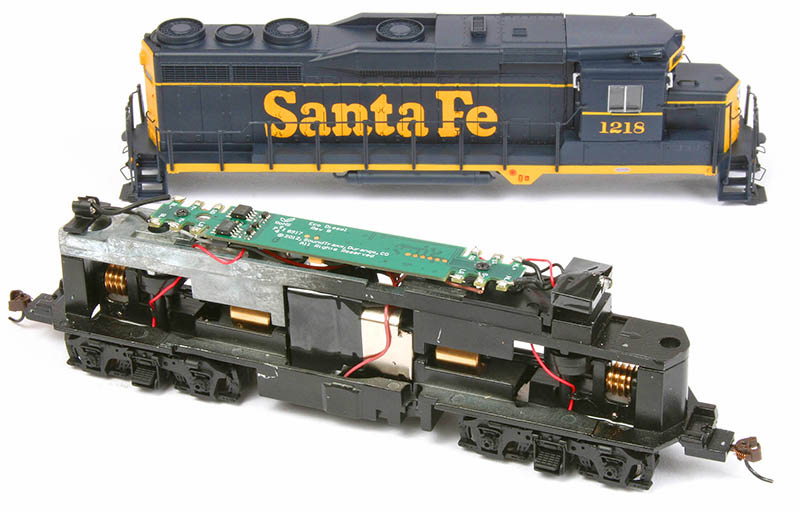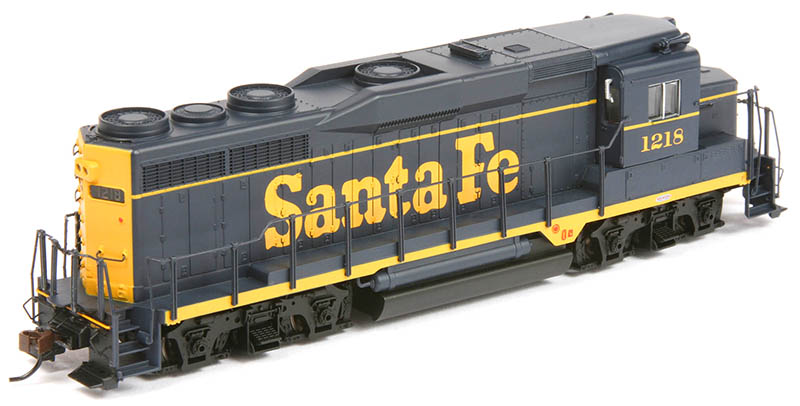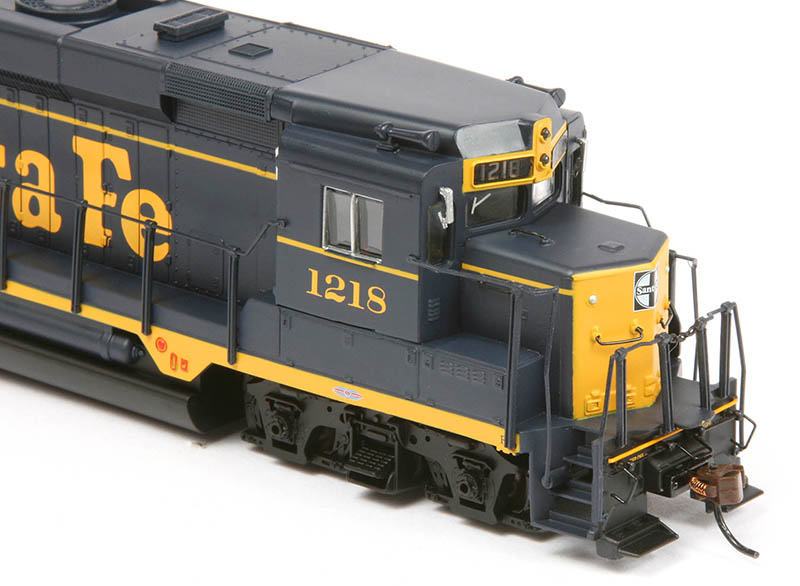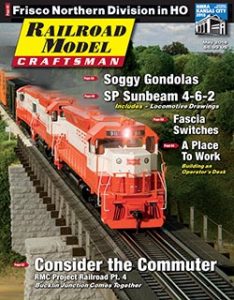 Review by David Otte/photos by the author except as noted
Review by David Otte/photos by the author except as noted
In an effort to keep our hobby affordable for the greatest number of participants and without foregoing all the hi-tech goodies completely, it has become a recent trend over the past couple of years for a number of the more mature model railroad manufacturers in the business to re-introduce examples of older toolings, with new paint and graphics, add factory-installed Digital Command Control (DCC) and sound, and release the model as a budget priced offering. Bachmann, in particular, has led the way with its line of “DCC Sound Value on Board” units utilizing Soundtraxx-designed electronics. Case in point is Bachmann’s latest HO scale re-entry, the Electro-Motive Division (EMD) GP30 diesel.
For its initial release, the manufacturer is offering its stylish GP30 with DCC-sound lettered for Baltimore & Ohio (reviewed in February 2018 Model Railroad News), Pennsylvania Railroad, Santa Fe, Southern Pacific, and Union Pacific railroads. Each road name comes in a single road number, and with a suggested retail price of $239. With many hobby dealers discounting these new units to a price well below the $200 mark, HO scale hobbyists can experience a DCC and sound model with good detail and decoration at a modest price. A sample painted up in Santa Fe’s popular blue-and-yellow “bookends” paint scheme serves as the focus for this review.
Like the rest of America’s railroads in the late 1950s, Santa Fe’s management was keeping a close eye on motive power developments as the transformation of the traditional four-axle diesel-electric locomotive began to take shape. In particular, when General Electric (GE) debuted its 2,500-hp U25B in 1959, the locomotive building industry was turned practically upside down. The new GE four-axle high-horsepower diesel featured such cutting edge technologies as a sealed carbody, a filtered centralized air intake system, and an equipment layout designed for ease of maintenance. Two U25Bs could do the job of three first generation diesel-electrics. Although not fully up to the new standards set by GE with its soon to be nicknamed U-Boat, Alco had also entered the market with the release of their 2,400-hp RS-27 the year before. Once again, to keep its edge on the market, EMD scrambled its design department as a locomotive horsepower race unfolded.

Santa Fe 1213 is on the point with three more GP30s eastbound at Sheffield Junction in the Kansas City area in
1967, all in their original livery. Bachmann’s new release is the first time the hobby company used Santa Fe’s as-delivered
dress on its HO-scale GP30 model. Unfortunately, Bachmann adorned their model with the incorrect nose logo. The
prototype logo was not black and white but was blue on the yellow nose background. Furthermore, the lettering style
should have been the Cooper Black-style font not the earlier thin, decorative font. Stuart J. Sutton photo, Kevin EuDaly collection
The LaGrange, Ill., builder had most recently introduced its 2,000-hp GP20 model, having been finally convinced by the western railroads in particular to turbo charge its popular model 567 prime mover in order to gain more horsepower. With the higher output being advertised by the competition though, EMD engineers went back to the drawing board in order to try and milk the turbocharged 567 series engine for yet more power. Meanwhile, EMD’s carbody designers approached their counterparts at General Motors’ automotive design group for a lesson in modern styling that would make its latest offering, which originally carried the internal designation of “GP22,” a real standout in the crowd. In a record 22 month time period, the diesel erector managed to create an interim locomotive that could compete with GE and Alco. While engineers could only boost its new locomotive’s power by a mere 250 horsepower, the marketing department cleverly masked this fact by simply giving EMD’s latest offering a higher number designation than what its competitor’ used on their new locomotives. The end result was EMD’s rollout of the GP30 in 1961.
The most distinctive visual characteristic of the 56 foot, 2 inch long EMD road unit had to be the new cab profile. Unlike the arc-shaped roofs of all EMD designs to date, the GP30s roof was artistically fashioned to sweep backwards, matching the height of the unit’s taller electrical cabinet, and continued aft to form a fairing that met the dynamic brake housing. At the heart of the new Geep contender was its 16-cylinder 567D turbocharged engine rated at 2,250-hp, which, although mediocre at best considering the competition’s power output, did offer customers proven dependability. Besides the now sealed electrical compartment, the 250,000-pound GP30 also boasted improved wheel-slip control, higher capacity traction motors, a nominal 66,000 pound starting tractive effort, and an inertial style air filtration system, which eliminated all carbody filters and supplied fresh air via a single blower to the main generator, traction motors, and air compressor – an arrangement that became the standard for future locomotive design.

For a second time, despite the slight difference in horsepower, EMD proved to be the leader as it entered the age of the second generation diesel-electric with a total of 948 GP30s sold to some 29 different North American railroads by the end of production in 1963, as compared to the 478 GE U25Bs and 27 Alco RS27s produced. Both the company’s reliability record, in regard to its proven 567 prime mover, and the marketing department’s ploy had certainly paid off with the GP30 holding the field for EMD until its true 2,500-hp GP35 arrived on the scene in 1963.
While Santa Fe would give GE a shot by purchasing 16 U25Bs in 1962 and 1963, its motive power management still favored the proven reliability of its massive EMD-built fleet and ordered 35 of the new GP30s for delivery by the summer of 1962, numbered 1200 – 1234, with an additional 50 units following a year later, numbers 1235 – 1284. By mid-1970, Santa Fe’s GP30s would receive renumbering into the 3200-series and, after being rebuilt about a decade later (now designated GP30u), the survivors went into the road’s 2700 class. The bulk of these surviving units would later be rostered by the BNSF after the 1995 merger.
As with most diesel prototypes, production phases play an important role in accurately rendering any road-specific GP30 and a brief discussion is in order. While the major demarcation in production alterations surrounds the cab, many minor changes occurred to the rest of the GP30 carbody. As a result, diesel-electric aficionados have delineated up to nine different sub-phases with some additional slight variations in the designations existing between individual interpretations. As such, for this review, I have used the phases as described by Robert Sarberenyi on his web site.

Santa Fe’s first GP30 units delivered were considered Phase Ia models, while the second group members ranged from Phase Ic to Ie variants. First, regarding the cab, per Union Pacific’s request for a third crew seat early in 1962, EMD moved the rear wall back on the fireman’s or left side of the cab by 10 inches to accommodate the additional crewmember. The builder later made the larger cab a standard feature beginning in November 1962, the late Phase Ib GP30, while still maintaining the older two-piece panel below the inertial air intake (located directly behind the left side of the cab). The detail would be replaced by a single-cover plate before the end of November 1962 making GP30 Phase Ic examples. Phase Id and Ie GP30s would see larger radiator grilles and top-mounted square sanding hatch covers respectively. EMD Phase II production commenced in June 1963 and displayed the previous phase upgrades, but had a redesigned inertial air intake grille featuring two vertical stiffeners rather than the single horizontal brace as shown on all as-delivered Phase I examples.
As far as the HO Bachmann GP30 rendering goes, the carbody shell, the tooling for which dates back to 1975 and Lionel-HO, is a good example of a late Phase Ic variant with extended cab and one-piece panel below the inertial air intake; so not the best match for Santa Fe 1218 as the model comes numbered. Then again, I don’t really expect a budget line model to match production phases necessarily, nor include road-specific details. Bachmann’s GP30 has actually aged well and still displays fairly decent molded-in details along with separately applied wire grab irons on the hood ends and coupler cut levers installed on the pilots. This revisions came when the manufacturer upgraded this model to the Spectrum product line in 1988. Both the dynamic brake fan and forward radiator cooling fans are somewhat see-through in design, but the balance of the cooling fans remain solid, as do all the various air intake grilles. The spacing between the three radiator fans at the end of the long hood is too wide compared to prototype placement.

Furthermore, the approximate 8-inch long model (over the coupler pulling faces), which correctly reflects general scale body proportions of the prototype, also exhibits add-on single note air horns on either side of the cab, exhaust stack, plastic handrail and stanchions, and one-piece molded truck sideframes. The older versions’ unusual combination of bulky windshield wipers added to the cab front side windows, while also utilizing molded-in painted wiper blades on the windshield, are, unfortunately, still present.
On the other hand, the model has lost its poorly depicted seated cab figures of the Spectrum days and the once open cab side windows now feature glazing with simulated metal framing visible, a much improved look in my book. An area of improvement for this model would be to correct the spacing of the headlights between the number boards on the front of the unit over the cab. The lights are currently somewhat equally spaced apart on the vertical section and actually should reside close together and oriented to the top of the this section.
The exterior finish meets current industry standards with smooth paint application and sharp graphics, all of which depicts the as-delivered appearance of Santa Fe 1218. Delivered in May 1962, this unit would trade its “bookends” for Yellowbonnet scheme sometime after mid-1972, having already been renumbered 3218 a few years before. By early 1982, Santa Fe rebuilt this and other GP30 roster members with a new 645 series 2,500-hp prime mover, designated a GP30u, and numbered 2718. The Geep would later operate as BNSF 2418, until being retired and sold in late 2012.
 Like its more recent incarnations, the HO-scale Bachmann GP30 maintains its heavy die-cast metal chassis with flywheel-equipped can motor powering all drive axles and all wheels acting as electrical pickups; no traction tires are used. Long gone are the old horn-hook style couplers, they’ve been replaced plastic E-Z Mate Mark II operating knuckle couplers. The trucks are remain positioned too close together by about a scale foot and half, when compared to the prototype. It is worth noting, however, that Railroad Model Craftsman’s sample did meet National Model Railroad Association (NMRA) standards in regard to wheel set gauging and couple height.
Like its more recent incarnations, the HO-scale Bachmann GP30 maintains its heavy die-cast metal chassis with flywheel-equipped can motor powering all drive axles and all wheels acting as electrical pickups; no traction tires are used. Long gone are the old horn-hook style couplers, they’ve been replaced plastic E-Z Mate Mark II operating knuckle couplers. The trucks are remain positioned too close together by about a scale foot and half, when compared to the prototype. It is worth noting, however, that Railroad Model Craftsman’s sample did meet National Model Railroad Association (NMRA) standards in regard to wheel set gauging and couple height.
As alluded to earlier, this latest rendition of the GP30 includes a cost-effective DCC-sound package that provides for all the basic operating features a modeler requires. Highlights of the NMRA-compliant sound decoder include: the rumble of an authentic EMD 567 series prime mover; three different air horn recordings from which to choose: Nathan M5 (default), Leslie A200, and Leslie S3L, with both separate short- and long-blast function keys; mechanical bell; dynamic brake cooling fan sounds; headlight on/off; headlight dimmer; and a mute button for silent running.
Also included is Soundtraxx’s Hyperdrive throttle enhancement, mainly Back-EMF (back electromotive force) or “cruise control,” which provides for smooth and consistent performance through all speed ranges in 128 speed step mode. LED equipped front and rear headlights and numberboards are present too, but not directionally controlled as delivered with both ends illuminated at all times; so some re-programming of control variables (change CV 33 to a value of “1” and CV 34 to “2”) will be necessary for the preferred directional lighting practice (see Soundtraxx’ guide for decoder specifics beyond the included “Quick Start Guide” accompanying the model).
Taking RMC’s sample for a test drive, I found all of the attributes of the value sound decoder to work as advertised with the roar of the diesel engine and the modeler activated signaling devices quite audible, as the sounds emanated from the rather small one-inch diameter speaker housed in the removable fuel tank. Out-of-the-box speed range was not bad, starting at just under 3 scale miles per hour, but our sample was a bit of a speed demon with its high end approaching the century mark; so another programming adjustment would be necessary to get that maximum down closer to the prototype’s typical 65 mile per hour gearing. Last but not least, the 13.2 ounce HO-scale GP30 comfortably handled 26 pieces of mixed freight rolling stock on a mostly level test pike, which was equipped with minimum 22-inch radius curves and No. 4 turnouts.
Bachmann’s latest GP30 release is all what it claims to be – a DCC sound value model that offers the novice plenty of opportunity for learning the basics of command control operation and programming while also providing those more experienced hobbyists on a strict budget an attractive looking model with all the current tech.
Bachmann Trains
1400 East Erie Avenue
Philadelphia, Pennsylvania 19124
215-533-1600




